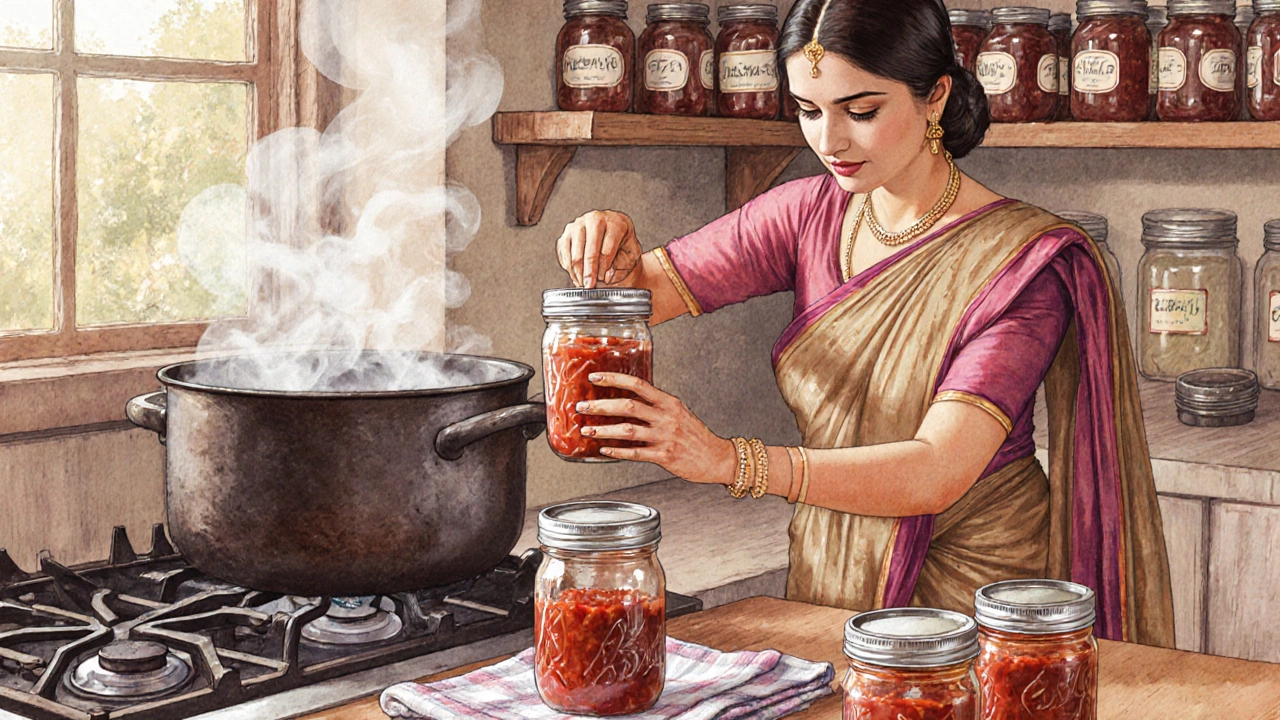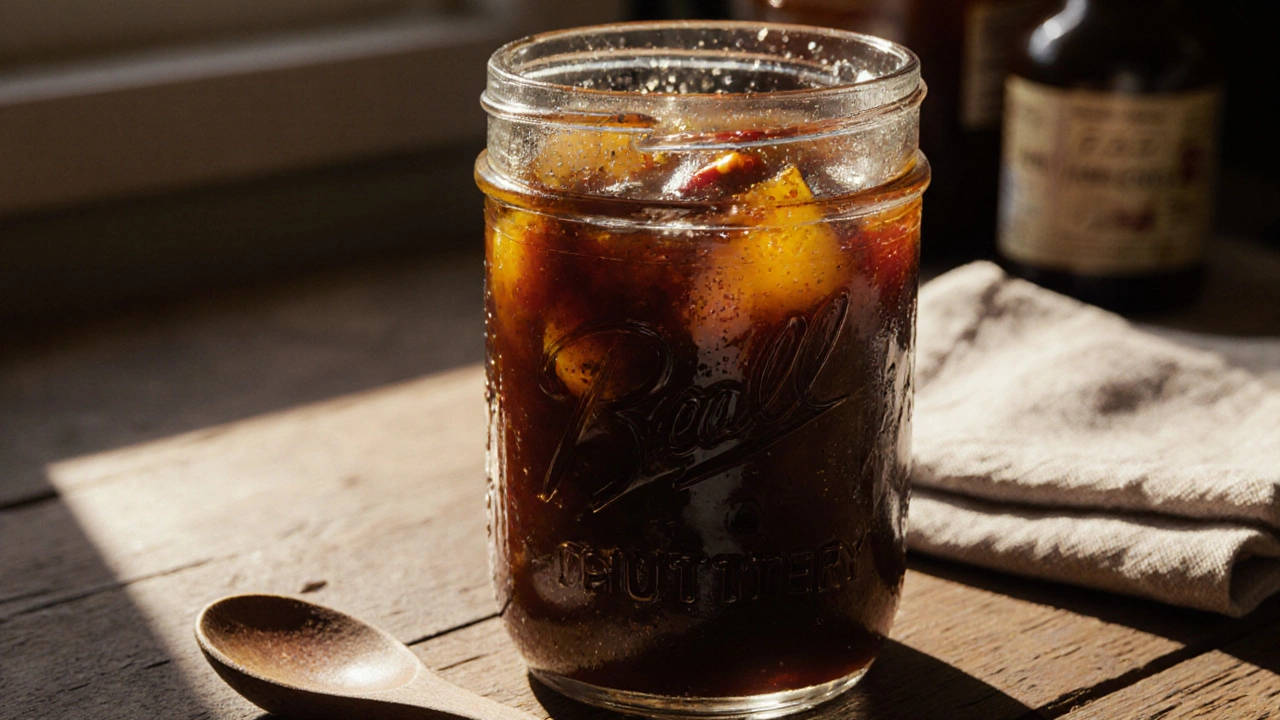Chutney Shelf Life Calculator
How Long Will Your Chutney Last?
Select your chutney type, ingredients, and storage method to get a realistic estimate of shelf life.
Select your chutney parameters and click "Calculate Shelf Life" to see the results.
Important: This is a general estimate. Always check for signs of spoilage before eating.
For canned chutney, shelf life is based on proper water bath processing.
After opening, move to refrigerator regardless of storage method.
Ever made a big batch of mango chutney or cilantro mint chutney, only to wonder weeks later if it’s still good? You’re not alone. Homemade chutney is packed with flavor, but it doesn’t come with an expiration date on the jar. Unlike store-bought versions with preservatives, your homemade batch relies on vinegar, sugar, salt, and proper storage to stay safe and tasty. So how long does homemade chutney last in a jar? The answer isn’t one-size-fits-all-it depends on how you make it, how you store it, and what’s in it.
What Makes Homemade Chutney Last Longer?
Chutney survives because of three natural preservatives: acid, sugar, and salt. Vinegar (usually white or apple cider) lowers the pH, making it hard for bad bacteria to grow. Sugar pulls moisture out of the mixture, and salt does the same while also killing off microbes. When these three work together, they create an environment where chutney can sit for months.
But here’s the catch: if you skip the vinegar, use too little sugar, or don’t sterilize your jars, your chutney won’t last. A simple cilantro chutney made with just herbs, lemon juice, and garlic? That’s a fridge-only item. A thick, cooked mango chutney with two cups of sugar and a cup of vinegar? That can last over a year-if sealed right.
How Long Does Chutney Last in the Fridge?
If you’re storing chutney in the fridge, most types last between 3 to 6 weeks. But there are exceptions:
- Raw chutneys (like mint-coriander, coconut, or tomato chutney with no cooking) last 2-3 weeks. They’re fresh, bright, and full of enzymes that break down over time.
- Cooked chutneys (mango, tamarind, onion) with vinegar and sugar can go 4-6 weeks. The heat from cooking kills bacteria, and the sugar/vinegar combo slows spoilage.
- Oil-based chutneys (like some South Indian peanut or sesame chutneys) last 3-4 weeks. Oil can go rancid, so watch for that stale smell.
Always use a clean, dry spoon every time you scoop out chutney. Even a tiny bit of water or food debris can introduce mold or bacteria. I’ve seen people use the same spoon for weeks-then wonder why their chutney turned weird. Don’t be that person.
How Long Does Chutney Last in the Pantry?
Only if it’s properly canned.
You can’t just pour hot chutney into a jar, screw on the lid, and leave it on the counter. That’s how botulism happens. For chutney to last safely at room temperature, you need to process it using a water bath canning method.
Here’s what you need:
- Chutney with at least 5% acidity (vinegar or lemon juice)
- High sugar content (1 cup sugar per 2 cups fruit/vegetable base)
- Hot, sterilized jars with two-piece lids (band and seal)
- A boiling water bath for 15-20 minutes
Once processed, sealed jars can sit in a cool, dark pantry for up to 12 months. After opening, move them to the fridge and use within 6 weeks.
Pro tip: If you see bubbles rising after sealing, or the lid pops when you press it, toss it. That’s not fermentation-it’s gas from bad bacteria. Botulism doesn’t always smell or look bad. When in doubt, throw it out.

Signs Your Chutney Has Gone Bad
Chutney doesn’t always scream "I’m spoiled." Sometimes, it just looks… off. Here’s what to watch for:
- Mold - fuzzy spots, green, white, or black. Even a tiny dot means the whole jar is unsafe.
- Off smell - sour, yeasty, or alcoholic. Fresh chutney smells sharp and bright. If it smells like wine or vinegar gone wrong, it’s bad.
- Change in texture - if it’s slimy, separated, or bubbling without being shaken, don’t risk it.
- Leaking or bulging lid - a sign of gas buildup inside. That’s a red flag.
One time, I made a batch of plum chutney and forgot about it for 10 months. The lid was still sealed. I opened it, sniffed-it smelled fine. Tasted a tiny bit. It was still sweet, tangy, and firm. No mold. No weird smell. That’s the exception, not the rule. I ate it, but I didn’t serve it to anyone else.
Freezing Chutney: A Smart Alternative
If you’re unsure about canning or want to keep chutney longer than 6 weeks in the fridge, freeze it. It’s the easiest way to preserve flavor without chemicals.
Here’s how:
- Portion chutney into ice cube trays or small freezer-safe containers.
- Leave half an inch of space at the top-liquids expand when frozen.
- Label with the date and type.
- Freeze for up to 12 months.
Thaw overnight in the fridge. Once thawed, use within 2 weeks. Freezing doesn’t kill bacteria, but it stops them from growing. It also preserves color and texture better than refrigeration for raw chutneys.

Best Jars for Storing Chutney
Not all jars are created equal. Glass is the only safe option. Plastic can absorb flavors and may leach chemicals over time.
Look for:
- Mason jars - the gold standard. Wide mouth makes filling and scooping easier.
- Sturdy, thick glass - thin jars can crack during canning or freezing.
- Two-piece lids - flat metal lid with rubber seal and screw band. Reusable bands, but never reuse seals.
- Clear glass - lets you see mold or discoloration.
Avoid jars with plastic lids or twist-off caps from jam jars unless they’re specifically labeled for canning. They don’t seal properly.
How to Extend Your Chutney’s Life
Want your chutney to last longer without canning? Try these tricks:
- Boil the vinegar first - this drives off water and concentrates acidity.
- Use more sugar - a 1:1 ratio of fruit to sugar is ideal for long-term storage.
- Add salt - at least 1 teaspoon per cup of chutney helps preserve.
- Don’t add fresh herbs at the end - if you want long shelf life, cook herbs in. Fresh cilantro or mint added after cooking will turn brown and slimy fast.
- Store in the coldest part of the fridge - not the door. Temperature swings shorten life.
One trick I learned from a grandmother in Kerala: after cooking, pour hot chutney into sterilized jars, then wipe the rim with a vinegar-soaked cloth before sealing. It prevents mold from forming on the lip.
When to Make a Fresh Batch
Chutney is at its best in the first 2 weeks. After that, flavors mellow, color fades, and texture softens. If you’re making it for a special meal, don’t rely on something that’s been sitting for months.
Make small batches. Two cups of chutney lasts a family of four about 3 weeks. That’s perfect. You’ll always have fresh flavor without waste.
And if you’re ever unsure? Taste a tiny bit. If it tastes like what you remember-bright, tangy, spicy-it’s fine. If it tastes flat, sour, or weird? Pitch it. Your stomach will thank you.
Can you reuse chutney jars for canning?
Yes, you can reuse glass jars and screw bands, but never reuse the flat metal lids. The sealing compound is designed for one use only. A reused lid won’t create a proper vacuum seal, which means your chutney won’t last in the pantry.
Does chutney need to be refrigerated after opening?
Yes, always. Even if it was canned and stored in the pantry, once you open the jar, you introduce air and bacteria. Refrigeration slows down spoilage and keeps flavors fresh. Don’t leave opened chutney on the counter.
Can you make chutney without vinegar?
You can, but it won’t last long. Vinegar is the main preservative. If you skip it, you’re relying only on sugar and salt, which isn’t enough for safe long-term storage. Raw chutneys without vinegar should be eaten within 3-5 days and kept refrigerated.
Why does my chutney turn brown?
Browning is usually oxidation, not spoilage. It happens with fruits like mango or apple when exposed to air. It’s safe to eat, but the flavor may be duller. To prevent it, add a splash of lemon juice during cooking and store in airtight containers with minimal headspace.
Can you freeze chutney in plastic containers?
Yes, but only if they’re freezer-safe. Look for the snowflake symbol on the container. Avoid thin, cheap plastic-it can crack or absorb odors. Glass jars with wide mouths work best for freezing, as they’re less likely to break.
